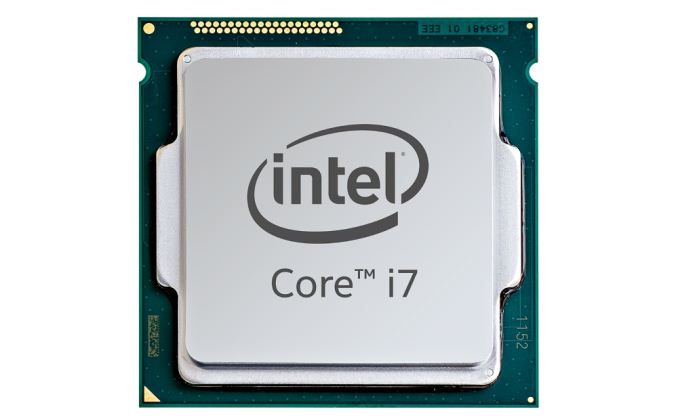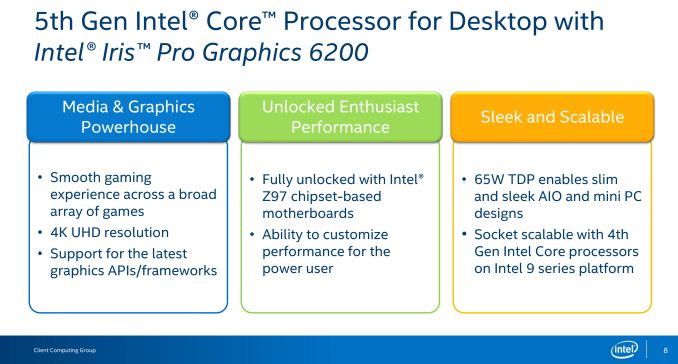The Intel Broadwell Desktop Review: Core i7-5775C and Core i5-5675C Tested (Part 1)
by Ian Cutress on June 2, 2015 7:45 AM ESTBroadwell-DT: Initial Thoughts
The new Broadwell desktop processors are somewhat out of sync with our regular expectations from Intel. Due to issues surrounding the 14nm node, as well as the cost, the whole Broadwell line from tablet to table-top has come out slower and more staggered than any Intel release in recent memory. As a result, the initial launch from Intel today is a pair of 65W desktop socketed models backed up with three 65W soldered down models whose true heritage is a chip primarily designed for large laptops and all-in-one devices.
Normally we would expect a range of desktop models from 35W up to 88W or higher, but socketed Broadwell-DT today only exhibits two units at 65W. This immediately puts a slight damper on those expecting to upgrade from Haswell’s high-end, or those wanting to go from something like a Pentium G3258 on Haswell to Broadwell’s top SKU. As a result, we have to keep our expectations in check – 65W should on paper perform nearly as well as an 88W part would, except it would be reduced by several hundred MHz. Meanwhile as these processors are also fully-unlocked and overclockable, we're left to ponder whether or not the stock frequencies actually matter in that case.
Due to the differential tangent at play, these processors also exhibit Intel’s best integrated graphics package, Iris Pro (GT3e), previously reserved only for soldered down/laptop/mini-PC orientations. This graphics package comes with largest number of execution units available from Intel, 48, alongside 128MB of eDRAM that acts almost like an L4 cache. This helps alleviate memory bandwidth pressure by providing a large(ish) pool near the CPU but with lower latency and much greater bandwidth than main memory. The eDRAM has the greatest effect in graphics, but we also saw some moderate increases in our non-3D regular benchmark suite.
The benefit of the graphics package, Iris Pro 6200, means that Broadwell-DT takes the crown as the fastest socketed graphics available. Our testing showed that the even the second-tier socketed SKU, the i5-5675C, outgunned the previous title holder, AMD’s A10-7870K. Despite having the i7-5775C in to test, due to time and firmware issues, we were unable to run the numbers on the integrated graphics but will do so in a later piece.
The key element to Broadwell-DT is not to consider it a natural successor to Haswell. It doesn't so much replace Haswell-K at this time, so much as it occupies a space Intel has left neglected since the launch of Haswell – the ultimate Intel integrated graphics solution. For users on integrated graphics, where money is no object, Intel now offers you the option to combine the regular CPU performance associated with Intel and a GPU that has the added performance benefits of on-chip, high-bandwidth eDRAM. The only question is whether that combined performance is worth the potential cost, and some would say no, pointing at a combined APU + GPU solution for equivalent or better gaming performance for the same price.
Pricing for the i5-5675C is listed as $276, slightly higher than the price of the i5-4690K which is at $236 on Amazon (reduced from $265). The i7-5775C is a bit higher at $366, also a margin higher than the i7-4790K which is $339 (reduced from $380). This makes Broadwell a tough sell right now in most circumstances unless you are absolutely limited to integrated graphics and want the best solution possible in a configurable PC. Given that Intel has also mentioned Skylake in their recent Computex keynote, it implements an abnormal situation that Intel has never been in with a new platform being talked about in the same breath. We have been told that these parts exist because users wanted them, and it has been interesting to see just how the added eDRAM changes the performance with discrete graphics in the mix.












196 Comments
View All Comments
extide - Tuesday, June 2, 2015 - link
Have you ever overclocked a CPU before? Those limits are easily raised, and a properly O/C'd build will not throttle...DCide - Tuesday, June 2, 2015 - link
It's hardly elite - just live video. But if the CPU saturates or crashes, everybody will know.I'm not skilled at overclocking. But for this application, stability is paramount. I wouldn't want to push it close to the limit, only to have it crash 5 hours into the stream. When I tested 4-core CPUs I had to run at low resolutions, or else the video would stutter. And I even at that I couldn't use all the features of the application.
With the same low-profile case and the same heatsink/fan the 4790K would throttle in less than 30 minutes while the 5820K and 5960X never would. They were all running at 4GHz. I'm sure someone more skilled could make all 3 CPUs run faster. But the 8-core is still going to be about twice as fast as the 4-core.
On the topic of the new CPUs, I won't be surprised if they O/C well enough to make them dominate the previous generations. But they won't be a match for the 2011-3 CPUs.
vision33r - Tuesday, June 2, 2015 - link
If you're into server workloads, 8 cores would nice. For gaming, more cores only adds more heat and hardly any benefit to gaming performance. For gaming, quad-core is good enough with no integrated GPU. All this integrated GPU stuff is just a waste of resources. Most of us into performance and gaming don't want the extra heat and power consumption.FlushedBubblyJock - Sunday, June 14, 2015 - link
If the kiddies can play WoW on it, amd and intel are happy. They will never stop.Galatian - Tuesday, June 2, 2015 - link
Would like to see some Quicksync Benchmarks! Anand noted fast Quicksync performance on the Iris Pro 5200, so I sure would like to see a) the differences between GT3e (Haswell) and GT3e (Broadwell) and b) the differences between GT2 (Haswell) and GT3e (Broadwell).Refuge - Tuesday, June 2, 2015 - link
I think that is coming in part 2 judging by the first two pages of the article.Kevin G - Tuesday, June 2, 2015 - link
I'll second the request for QuickSync testing. I do a bit of video editing with Vegas and do some bulk conversions with Handbrake so I have a keen interest on this topic.dj_aris - Tuesday, June 2, 2015 - link
I'd like to see the 65w 4770R in the charts to measure the delta over a a generation (okay half a generation). Meanwhile, considering that i5-5675C is $276 but games much worse than a Haswell Pentium + a decent $200 discrete card I really don't see the point in traditional desktops. The only scenario I see fit would be in a tiny case using a super low profile thin mini-ITX board, so as to create a system similar to, say, an Alienware Alpha. But wait, there aren't any thin mini-ITX H or Z97 boards. Whereas back with Haswell we had thin mini boards but only non-Iris iGPUs. Oh Intel, there's always a part missing!DCide - Tuesday, June 2, 2015 - link
I think you mean you don't see the point for a gaming desktop. A Pentium + $200 dGPU would be a poor choice for most traditional desktops.Mech0z - Tuesday, June 2, 2015 - link
With DX12 supporting multiGPU much much better, could it be theorized that these will be very good for DX12 games together with a dGPU?